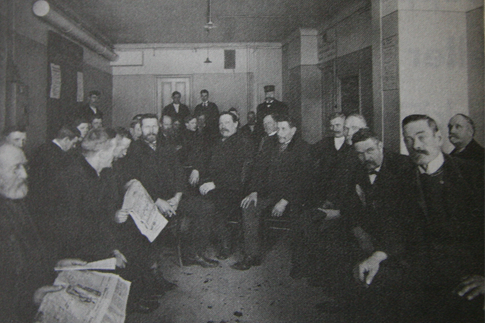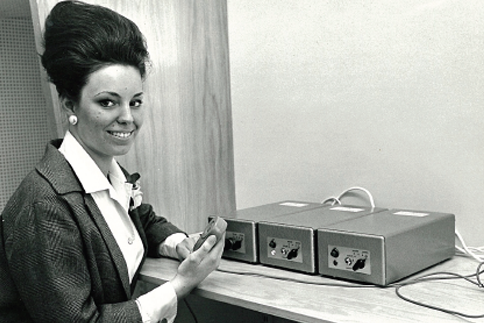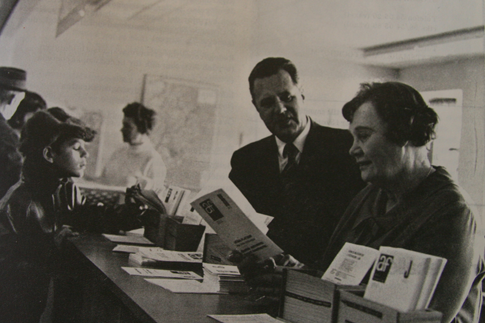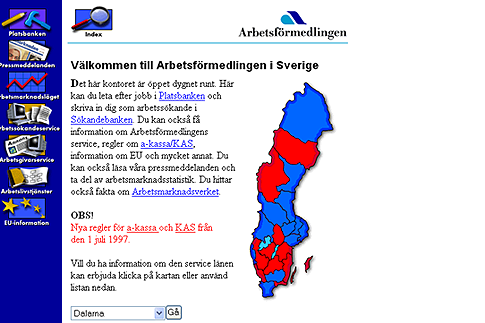Our history
The story of Arbetsförmedlingen stretches back more than 100 years. Over the years we have always adapted our operations to changes in society and the needs of the labour market. Here are some milestones.
Our history
Sweden’s first employment office opened in Helsingborg in 1902, a neutral meeting place for jobseekers and employers. The film was produced in 2012. (In Swedish)
Arbetsförmedlingen year by year
1902: The first employment office
Sweden’s first employment service office is opened: Helsingborgs Stads Arbetskontor. A municipal employment office in a former hospital building.


Photo from a waiting room at the bakers’ employment office in 1936.
1940: The service is nationalised
Statens Arbetsmarknadskommission is established with the task of administering labour market policy programmes. The employment offices are nationalised and county employment boards are established.
1948: New government agency with a nationwide responsibility
Statens Arbetsmarknadskommission is reformed and becomes Arbetsmarknadsstyrelsen, which is tasked with overarching responsibility for Arbetsmarknadsverket. This new government agency is tasked with implementing central government labour market policy throughout the country.
1949: Vocational guidance recommendation
The specialised UN agency International Labour Organisation (ILO) adopts a vocational guidance recommendation.
1951: 1.2 million jobs are matched
The Swedish Trade Union Confederation (LO) economists Gösta Rehn and Rudolf Meidner present the report ”Fackföreningsrörelsen och den fulla sysselsättningen” (The Trade Union Movement and Full Employment) at the LO congress.
The employment offices match 1.2 jobseekers with vacancies.
Paid holiday is extended to three weeks.
1963: Platsjournalen starts being published
The magazine Platsjournalen is launched as a part of the journal Arbetsmarknaden that is published monthly. The magazine has a handful of editorial articles but it primarily consists of job advertisements.
1964: “Assistance” becomes “insurance”
The compensation from unemployment insurance “daily assistance” (daghjälp) changes its name to “daily allowance” (dagpenning). The change in name is to highlight that this is an insurance policy and not a form of assistance.
The five-day week is introduced.

Britt Hollström was awarded the title Fröken Plats in 1964. She stopped working at Arbetsförmedlingen in Mölndal in 2007.
1970: A bill for a more equal labour market
The first bill to combat gender discrimination in the labour market via legislation was written by the Swedish Liberal Party. The purpose was to speed up development towards a more gender equal labour market.

Photo from Arbetsförmedlingen in Uppsala in the 1970s.

Photo of the window of Arbetsförmedlingen Eslöv-Hörby-Höör when there was a great demand for labour in the early 1970s
1971: District offices with complete service
Arbetsförmedlingen now has 69 district offices that are to offer applicants complete service. Under the district offices there are 166 local offices.
The employment subsidy is introduced so that employers can receive financial compensation for employing a person.

Photo from Arbetsförmedlingen in Skärholmen 1971.

Photo from Arbetsförmedlingen in Avesta in the 1970s.
1974: Protection for employees is expanded
- Potential for in-house training within the company as an alternative to redundancy or termination of employment is introduced on a trial basis. The Employment Protection Act is introduced. The purpose of this act is to provide employees with better protection in the event of redundancy and dismissals. The employment inquiry is appointed, as is the inquiry into vocational rehabilitation.
- Cash labour market support (Kontant arbetsmarknadsstöd, KAS) is introduced. KAS was paid to unemployed people who were neither a member of an unemployment insurance fund nor entitled to unemployment benefits.
- The Act concerning certain Measures to Promote Employment is introduced. Employers planning to cut back their operations are now obliged to notify Arbetsförmedlingen if at least five people are at risk of being made redundant (redundancy notice).
- It becomes possible to register as a jobseeker at the customer reception.
1976: The role of employers becomes increasingly important
- An act stating that employers have to report vacancies to Arbetsförmedlingen is introduced.
- Companies that provide additional training to their staff in exchange for the company employing replacements can receive financial support.
- The national retirement age is lowered to 65 and it becomes possible to choose partial pension.
- Employer’s contribution is introduced in order to cover some of the costs of employment training.
1980: Coordination of rehabilitation measures
The labour market institutes are established as a part of Arbetsmarknadsverket. The institutes are tasked with coordinating rehabilitation measures.
Samhällsföretag (now known as Samhall AB) is formed.
1995: Arbetsförmedlingen on the internet
The first website is launched. It features the Job Bank, the Jobseekers' Bank, press releases and information about our services, the state of the labour market and the rules of the unemployment insurance funds.

Photo of the website in 1997.
2003: Customer service by telephone
The customer service centre is opened in Sollefteå so that jobseekers can contact an employment officer over the phone. Over the subsequent years, customer service offices are opened in a further five locations.
2006: Tell us what you think of us
Satisfied or dissatisfied? Customer relations opens and everyone is welcome to let us know what they think of our activities via e-mail or phone.
2008: The government agency Arbetsförmedlingen is formed
Arbetsmarknadsverket is replaced by the new government agency Arbetsförmedlingen. The county employment boards are phased out.

Photo from Arbetsförmedlingen’s new premises in Skärholmen 2012.
2010: Introduction programme is introduced
The introduction reform was introduced on 1 December 2010 for the purpose of facilitating the integration of new immigrants in Sweden. When new immigrants receive a residence permit in Sweden they are supposed to find employment as quickly as possible. For this purpose, the introduction programme for new immigrants is launched and managed by Arbetsförmedlingen.
2011: The Job Bank became an app and customer services in other languages opened
The Job Bank app is launched which makes it possible to apply for work directly using a mobile phone. The Job Bank app was phased out in 2020. The online version of the Job Bank has better functionality than the app and is better from an accessibility viewpoint.
The customer service centre in Södertälje opens. Jobseekers who are new immigrants can phone here and talk to employment officers in Arabic, Somali, Persian, Russian and Tigrinya.

Photo of employment officers from Arbetsförmedlingen’s customer service centre in Södertälje 2012.
2012: National partnerships established
Arbetsförmedlingen initiates partnerships with 26 different national employers. In total, the agreements encompass approximately 1,800 job opportunities and work experience placements.
2014: The service Support and Matching is introduced
Support and Matching is for jobseekers who need enhanced and adapted support to look for work. The aim is to start working or studying as quickly as possible.
The service is delivered by providers that have been procured in accordance with the Act on Systems of Choice (LOV).
2017: Platsjournalen becomes digital
Sweden’s biggest job vacancy magazine, Platsjournalen, changes shape – from paper magazine to newsletter. The demand for paper magazines decreases in general due to new media consumption habits, not least among younger readers. In order to meet expectations, we move to offering articles, job-seeking tips, experts and other inspirational articles in an easily accessible, digital channel. Platsjournalen no longer exists and has been replaced by newsletters that jobseekers can subscribe to via e-mail.

Photo of Platsjournalen on an e-reader and mobile phone.
2019: arbetsformedlingen.se receives an award
arbetsformedlingen.se is awarded Sweden’s best news website by the technology website IDG.
2022: The reformation of Arbetsförmedlingen is completed
In the January 2019 agreement, the Social Democrats, the Center Party, the Liberals and the Green Party agreed that the Swedish Public Employment Service should be fundamentally reformed. On 1 December 2022, the changes in law and regulations that the government and the Riksdag decided on in June entered into force. Thus, the last pieces of the reform puzzle are in place and the conditions are in place for the Arbetsförmedlingen to operate as a reformed authority. The government will follow this up in a special government task that will be final reported in October 2023.